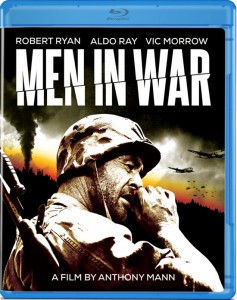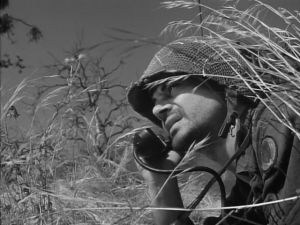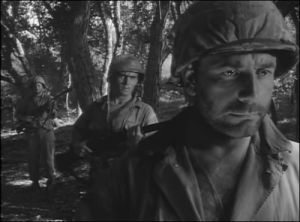
Written by Philip Yordan
Directed by Anthony Mann
USA, 1957
Director Anthony Mann was a specialist at genre filmmaking. From early crime dramas like T-Men and Raw Deal, to historical epics like El Cid and The Fall of the Roman Empire, he seemed to have a knack for working within — and working with — the conventions of a given generic formula. His Westerns, especially, are among the best that that particular type of movie has to offer. And when he set his sights on the war film, his natural aptitude for genre would be as prominent as it was anywhere. Men in War, from 1957, his second war film of the decade (released two years after Strategic Air Command), contains much of what makes Mann a distinct filmmaker, and reveals much of what makes the war film its own unique form of motion picture.
 Set in Korea, 1950, Men in War has a deceptively simple narrative set-up. A platoon of about a dozen exhausted men are isolated in enemy territory. They can’t establish friendly contact by radio and their closest point of safety is a hill miles away. Their truck has broken down, so they have to carry all their supplies. The men are weary, and one is very sick. But led by Lt. Benson (Robert Ryan), they soldier on and remain determined. As the primary plot is revealed, so too are the essential features of Men in War, and the war film generally. A printed statement at the beginning of the film declares, “Tell me the story of the foot soldier and I will tell you the story of all wars.” Indeed, this could be a war film about any war: its setting is mostly indefinite, the enemy is largely unseen, and many of the genre’s basic ingredients are present. This is what makes Mann’s work in diverse genres so fascinating. Before the 10-minute mark, he depicts the anxieties of the soldiers, their discomforts, their habits, their rations, the way they eat, their aliments, their gear, their equipment, the hazards inherent in war, and the seldom seen combat reality of downtime, when there is no action and the men are simply waiting. This range of features establishes what this group of men is like and what their status is at this point in the mission. It also acts as a larger commentary on the genre itself, filled as it is with so much of what defines the war film. Just as Mann’s Westerns are rife with the characteristic visual and thematic icons of that genre, Men in War is quickly shown to be a conglomeration of the war film’s key components. (This iconographic allusion was even present in the titles of certain of his Western films: Winchester ’73, The Tin Star, The Naked Spur, etc. As far as Men in War goes, its title plainly situates the film in its given genre; the next year, Mann would likewise release a Western called Man of the West. The importance and overt awareness of genre is obviously fundamental.)
Set in Korea, 1950, Men in War has a deceptively simple narrative set-up. A platoon of about a dozen exhausted men are isolated in enemy territory. They can’t establish friendly contact by radio and their closest point of safety is a hill miles away. Their truck has broken down, so they have to carry all their supplies. The men are weary, and one is very sick. But led by Lt. Benson (Robert Ryan), they soldier on and remain determined. As the primary plot is revealed, so too are the essential features of Men in War, and the war film generally. A printed statement at the beginning of the film declares, “Tell me the story of the foot soldier and I will tell you the story of all wars.” Indeed, this could be a war film about any war: its setting is mostly indefinite, the enemy is largely unseen, and many of the genre’s basic ingredients are present. This is what makes Mann’s work in diverse genres so fascinating. Before the 10-minute mark, he depicts the anxieties of the soldiers, their discomforts, their habits, their rations, the way they eat, their aliments, their gear, their equipment, the hazards inherent in war, and the seldom seen combat reality of downtime, when there is no action and the men are simply waiting. This range of features establishes what this group of men is like and what their status is at this point in the mission. It also acts as a larger commentary on the genre itself, filled as it is with so much of what defines the war film. Just as Mann’s Westerns are rife with the characteristic visual and thematic icons of that genre, Men in War is quickly shown to be a conglomeration of the war film’s key components. (This iconographic allusion was even present in the titles of certain of his Western films: Winchester ’73, The Tin Star, The Naked Spur, etc. As far as Men in War goes, its title plainly situates the film in its given genre; the next year, Mann would likewise release a Western called Man of the West. The importance and overt awareness of genre is obviously fundamental.)
As the men march forward, there’s a sudden shift in action. They see a jeep plowing through an open field. Given the proximity of the enemy, they assume the driver must be crazy to reveal himself like this, but more importantly, they see the jeep as a vital resource, something to assist in the movement of their supplies. Once they stop the speeding vehicle, they find Sgt. Montana (Aldo Ray) driving, and his passenger is a shell-shocked colonel (Robert Keith). Montana is reticent to divulge too much of his or the colonel’s backstory, so subsequently, Benson is skeptical about the sergeant’s true motivations. Benson commandeers the jeep and the group continues.
 The goal for the men is relatively clear. They have to reach the hill to obtain the upper hand, or at least some relief. But it’s a long haul, a grueling trek for a group disheartened and fatigued. In their weary physical and mental condition, and with prolonged periods of inaction, it’s easy for the men to lose focus. There’s the chance for complacency to settle in as they navigate the grounds without incident. They must avoid carelessness and remain on guard, for they know what can happen if they disregard their threatening circumstances. The murder of the mechanic, Killian (James Edwards), serves as a reminder. He sits and dreamily picks some flowers, stretches his legs, and neglects his surroundings. He is promptly dispatched by the hidden enemy. This particular death scene stands out, as Mann brilliantly films the slaying by showing first Killian’s twitching foot at the moment of the stabbing, and then simply showing the moving grass as the North Koreans quickly flee. On the other hand, the men can also become hypersensitive. See, for example, the mania, the sheer terror on their faces when they encounter landmines.
The goal for the men is relatively clear. They have to reach the hill to obtain the upper hand, or at least some relief. But it’s a long haul, a grueling trek for a group disheartened and fatigued. In their weary physical and mental condition, and with prolonged periods of inaction, it’s easy for the men to lose focus. There’s the chance for complacency to settle in as they navigate the grounds without incident. They must avoid carelessness and remain on guard, for they know what can happen if they disregard their threatening circumstances. The murder of the mechanic, Killian (James Edwards), serves as a reminder. He sits and dreamily picks some flowers, stretches his legs, and neglects his surroundings. He is promptly dispatched by the hidden enemy. This particular death scene stands out, as Mann brilliantly films the slaying by showing first Killian’s twitching foot at the moment of the stabbing, and then simply showing the moving grass as the North Koreans quickly flee. On the other hand, the men can also become hypersensitive. See, for example, the mania, the sheer terror on their faces when they encounter landmines.
The narrative trajectory of Men in War is extremely economical. The men essentially stay on one path, and every now and then, a new obstacle arises. Threats can be internal, as in the animosity between Benson and Montana, or external, as in the looming danger of the unseen enemy. In either case, Mann’s establishment of a clear goal and path allows drama to surface along the way, without apprehension about the audience forgetting the ultimate aim. It also allows for Mann to revisit any number of his frequent themes. First among these is the attention paid to loyalty and responsibility. Montana has a blind devotion to the colonel, the result, we find out, of a previously formed paternal bond. Similarly, the platoon is quick to obey Benson and trust his instincts. When an enemy soldier surrenders, the primary concern is to test his reliability. In a second, typically Mann motif of morally ambiguous heroes, Benson can be ruthless, but he has the respect of his men. He’s reasonable, driven, and strategic, and he can also be harsh and easily blinded by his objective. Third is location. Most prominently (and understandably) highlighted in his Westerns, Mann’s use of setting is one of his hallmarks. In Men in War, like in those Westerns, the environment serves a number of functions: it’s an impediment and it’s camouflage; it works against the men and it works for them; it affects their actions and thoughts and it influences their plans and determines their outcome.

When he was working, Anthony Mann never quite received the critical or industry recognition he deserves now in retrospect, though as the disc summary points out, his work here did warrant him a Director’s Guild award nomination, his second of three. Officially written by Philip Yordan (probably fronting for the blacklisted Ben Maddow), Men in War is, at any rate, a valuable entry in the fascinating, varied, and significant filmography of an American movie master.
— Jeremy Carr

